CALL, MESSAGE OR WHATSAPP ON 077 8069 8989
CALL, MESSAGE OR WHATSAPP ON 077 8069 8989
Skin Lesion and Cancer Removal in Nottinghamshire, Derbyshire, Bedfordshire and Hertfordshire
- Home
- Procedures
SKIN LESION AND CANCER REMOVAL
ABOUT SKIN CANCER
The incidence of skin cancer is highest in the whole body. The probability of getting skin cancer increases with age. Skin cancers tend to occur on any body part; however sun-exposed areas like the face, arms, neck and legs are more vulnerable. Frequent sun exposure during early life or sun burn can result in skin cancers developing during your later years.
Skin cancers can be cured completely by using various surgical and non-surgical techniques. The technique used depends on the type, position, size and spread of the cancerous cells, and the general health and age of the patient. The objectives of the treatment are complete cancer removal, rapid healing and restoration of a normal appearance of the skin.
OTHER SKIN CONDITIONS
In addition to moles, other lumps and bumps on the face or other parts of the body can be embarrassing for many and can lead to pain, distress and restriction of movement. The examples of such conditions are lipoma, fibroma,benign soft tissue tumours arising from sweat glands, hair follicles, sebaceous glands or nerve fibres like neurofibromas. Mr Javaid also routinely performs excision of benign soft tissue lumps and bumps in addition to benign skin lesions.
-
Remote 3D Video Consultation
How does it work:
1- Sign-up through this link
2- Upload 3 photos (front, right & left view)
3- Book your Remote 3D Consultation
Stay safe and have a Remote 3D Video Consultation from the comfort and privacy of your home, office or favourite place.
-
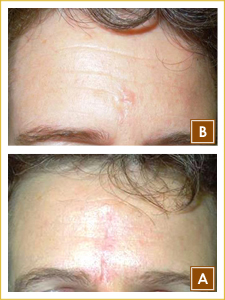
SKIN LESION - CANCER REMOVAL
Patient 1 - Before and After
-
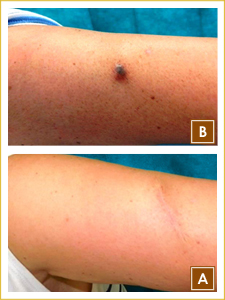
SKIN LESION - CANCER REMOVAL
Patient 2 - Before and After
-
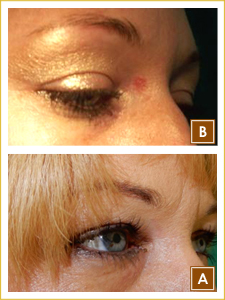
SKIN LESION - CANCER REMOVAL
Patient 3 - Before and After
-
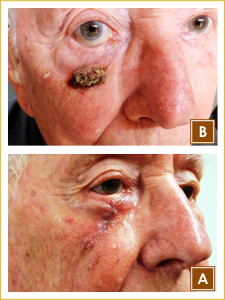
SKIN LESION - CANCER REMOVAL
Patient 4 - Before and After
-
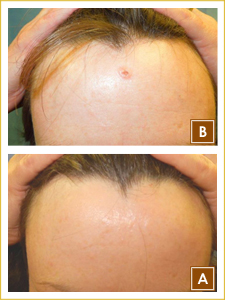
SKIN LESION - CANCER REMOVAL
Patient 5 - Before and After
-
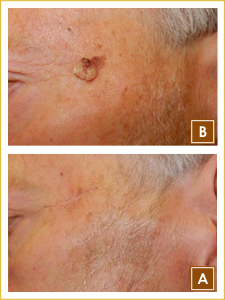
SKIN LESION - CANCER REMOVAL
Patient 6 - Before and After
-
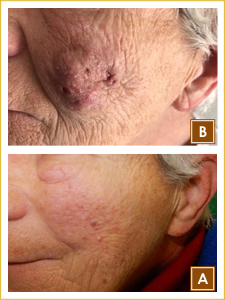
SKIN LESION - CANCER REMOVAL
Patient 7 - Before and After
-
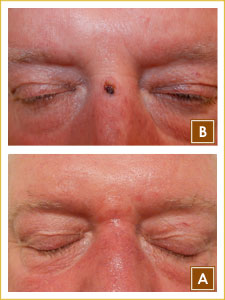
SKIN LESION - CANCER REMOVAL
Patient 8 - Before and After
-
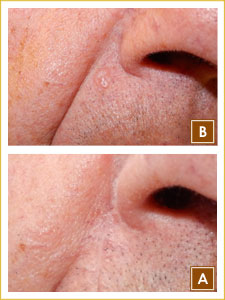
SKIN LESION - CANCER REMOVAL
Patient 9 - Before and After
-
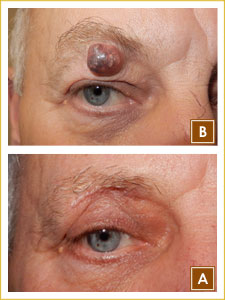
SKIN LESION - CANCER REMOVAL
Patient 10 - Before and After
-
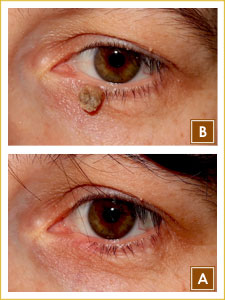
SKIN LESION - CANCER REMOVAL
Patient 11 - Before and After
-
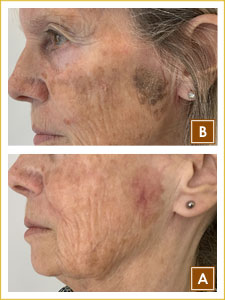
SKIN LESION - CANCER REMOVAL
Patient 12 - Before and After
TYPES OF SKIN CANCER
There are mainly 3 types of skin cancer - basal cell carcinoma, squamous cell carcinoma and malignant melanoma. The majority of skin cancer patients in the UK are diagnosed with basal cell carcinoma (BCC), which commonly occurs on the head or neck, but may be found on other parts of the body as well. Red patches, nodules, spots or scaly crusted areas which itch or bleed can be indications for this cancer. This cancer is also known as rodent ulcer as it sometimes appeasr as a non-healing ulcer and spreads deep into the underlying tissue.
Ulcers or scaly patches may often be signs of squamous cell cancers (SCC)and although they are less prevalent than basal cell cancers, they are more serious.
A Malignant Melanoma (MM) is indicated by brown or dark spots which may be flat or raised and have an irregular shape and pigmentation. Although less common, the severity of this type of cancer is higher as it can spread rapidly to other body parts.
With the help of specialised techniques, cancerous skin lesions can be removed to preserve your health and revive your appearance.
SKIN CANCER TREATMENT PROCEDURE - SURGICAL TECHNIQUES
EXCISION BIOPSY
Small cancers can be diagnosed and treated using this technique, in which cancerous skin is removed along with a small section of bordering tissue. The bordering cells are analysed under a microscope to ensure that no cancer cells are present. If results indicate cancer cells, further surgery may be needed.
CRYOSURGERY
Small cancers that haven’t grown deep into the skin are removed by applying liquid nitrogen; this freezes the affected area and removes the cancer. However, cryosurgery cannot be performed on delicate body parts such as eyes.
CURETTAGE AND ELECTROCAUTERY
Minor basal cell cancers are treated by this technique. The cancer is scraped away by using a curette. Any leftover cancer cells are killed by passing an electric current through an electric needle, this also helps to control any bleeding.
MMS OR MOHS MICROGRAPHIC SURGERY
MMS may be performed for treating: A recurrence of basal cell cancer. Proliferating basal cell carcinomas into surrounding tissues. Large cancers of the skin. Cancers in areas where only small amount of tissues can be removed, such as the nose and eyes. Rare cancers of the skin.
The procedure is slow and involves the removal of a small amount of tissue at a time, which is later examined for cancerous cells. If cancerous cells are found, the process is repeated until all cancerous cells are removed.
WIDE LOCAL EXCISION
In this process, skin tissue is removed based on the cancer type, the location and the extent of tissue already removed if an excision biopsy has been already been performed. Stitches are used to close the wound, which may cause skin tightness, however the discomfort will ease with time.
SKIN GRAFTS AND SKIN FLAPS
Skin cancer surgeries may require the removal of large areas of skin, which are then repaired by using a skin graft or skin flap.
SKIN GRAFTING
In this cosmetic procedure, a thin layer of skin or a full thickness of the skin,depending upon the need to reconstruct the defect is cut from a donor site and then positioned in the area which needs repair. Stitches are sometimes used to secure the area from where the graft has been taken.
SKIN FLAPS
In this operation a piece or a fold of skin, located close to the wound is used along with its underlying subcutaneous tissues. . The skin fold remains connected to its original site and is also placed above the new wound, secured together with stitches, the donor site is then sutured.
Other less common surgical methods include lymph node removal for squamous cell cancers and melanoma, and adjuvant treatment for eliminating chances of recurrent cancers. Non-surgical treatments include radiotherapy, chemotherapy, immunotherapy and photodynamic therapy.
POTENTIAL RISKS AND COMPLICATIONS OF SKIN CANCER SURGERY
Like other cosmetic surgeries, the possibility of risks cannot be ruled out. Complications are rare however, but could include bleeding, haematoma, infection, scarring, variation in skin sensation, recurrence of cancer, irregularity in skin contour, frozen section inaccuracy, swelling and pain, anaesthetic risks and persistent dissatisfaction with the appearance.
NEED FOR FOLLOW UP
The purpose of skin cancer surgery is to achieve a local control of cancer and to reduce the risk and possibility of the cancer recurrence and spreading to other body areas. However, local surgery cannot stop the cancer spread if cancer cells have already skipped beyond the local area and have seeded in the other body systems before the local surgery is performed. A periodic follow up of 3-5 years depending upon the nature of the skin cancer is recommended to spot any local, regional or systemic cancer spread. Mr Javaid will guide you accordingly about the need for follow up in your specific situation.
SUMMARY
Operation duration: 30-60 minutes. Anaesthesia: General/Local. Hospital Stay: Outpatient/Day case. time off work: 1-5 days depending upon complexity. Overall result: Visible from 2-6 months.
SKIN LESION AND CANCER REMOVAL ENQUIRIES
If you require any further information about Skin Lesion and Cancer Removal or the range of surgical and non surgical treatments provided by Mr Javaid or wish to book a consultation please contact us by completing our enquiry form or by using the following contact details:
Enquiries in Hertfordshire and Bedfordshire:Please speak to Mrs Pauline Titley (private secretary) on 077 8069 8989
Enquiries in Derbyshire and Nottinghamshire:Please speak to Mrs Pauline Titley (private secretary) on 077 8069 8989
You may also reach us via WhatsApp:Send us a message or call us from your mobile using WhatsApp.Our WhatsApp contact number is the same as the one you currently use to reach our Private Secretary Mrs Pauline Titley on 077 8069 8989.
Instagram Latest Posts
Skin Lesion and Cancer Removal
Sebaceous Cyst Removal
Lipoma Removal or Lipoma Excision
Thigh Lift, Thighplasty or Thigh Reduction
-
Remote 3D Video Consultation
How does it work:
1- Sign-up through this link
2- Upload 3 photos (front, right & left view)
3- Book your Remote 3D Consultation
Stay safe and have a Remote 3D Video Consultation from the comfort and privacy of your home, office or favourite place.
-
Mr Muhammad Javaid
-
 Qualifications: MBBS MSc FRCSG FRCS(Plast)Full Member of: BAAPS & BAPRAS
Qualifications: MBBS MSc FRCSG FRCS(Plast)Full Member of: BAAPS & BAPRAS
-






